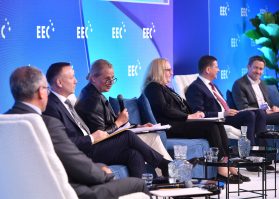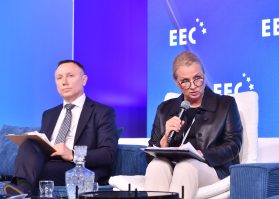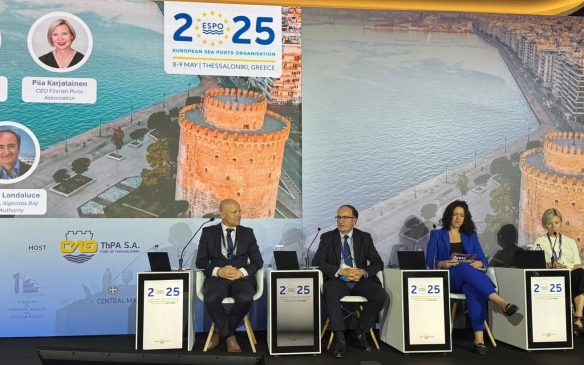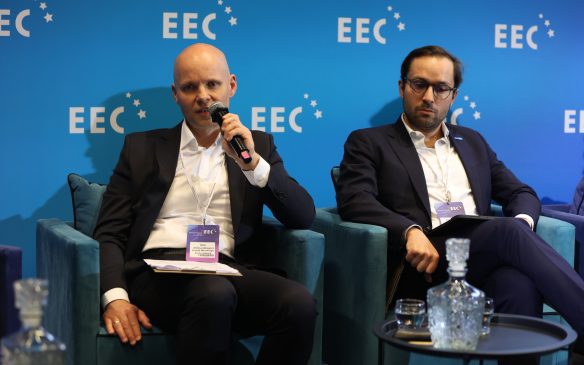Port of Gdańsk at EEC 2025: building resilience through investments
The Port of Gdańsk continues to strengthen its position as a strategic logistics hub in Europe amid geopolitical challenges and the growing importance of the Baltic Sea as a key transport and energy route. During the European Economic Congress, Dorota Pyć, President of the Port of Gdańsk, emphasised the importance of continued investment and the role of the Port of Gdańsk in building the country’s resilience.
During the panel discussion ‘Infrastructure investments: change and continuity’, the President of the Port of Gdańsk emphasised the enormous role played by seaports in everyday life. It is estimated that as much as 90% of global trade involves the sea. This means that most of the products we use every day – from electronics and clothing to food – reach us through ports, such as the Port of Gdańsk. They are the first link in the chain that provides access to consumer goods, energy resources and industrial components, which are essential for the functioning of the modern economy. For this reason, investing in modern, resilient and sustainable port infrastructure is not only a matter of economic development, but also of the safety and comfort of citizens.
‘We live in uncertain times, which may have a very negative impact on the functioning of ports that are of fundamental importance to the national economy. This is why we strive to build resilience, and we do so primarily through continuity. Investments are planned well in advance and go through many phases, which overlap and flow smoothly into one another. Changes? Of course there are changes, but they are related more to awareness in ports. There has been a change in the perception of port infrastructure as something that is not only used for the economic development of a country, but also for strategic objectives, such as ensuring food security. In these geopolitically difficult times, after the pandemic and given the effects of the war in Ukraine, we must be prepared in terms of infrastructure. Investments are extremely important to us, and ports should have some surplus capacity in terms of cargo handling capacity for various groups of goods’, said President Dorota Pyć.
The role of Baltic ports, including the Port of Gdańsk, as alternative and safe transport routes has become particularly important due to global tensions. The Port of Gdańsk responds to these changes by focusing not only on infrastructure development, but also on compliance with European climate regulations.
‘No matter what, we have to build competitiveness, and this requires continuous development. The Port of Gdańsk aspires to be a sustainable port in the blue and green economy, so we make sure to meet new EU legislative requirements. Hence, we are currently carrying out investments aimed at fulfilling the obligations imposed by European law’, said President Pyć.
The Port of Gdańsk is the most important Polish port in terms of the national economy and the main container hub of the Baltic Sea, which serves the world’s largest container ships. In 2024, the Port of Gdańsk served over 3,500 ships and handled over 77 million tonnes of cargo, reaching a net profit of PLN 264 million – over PLN 50 million more than in the previous year. According to data from the National Revenue Administration, in just one year (2024) cargo handling in the Port of Gdańsk generated over PLN 55 billion for the state budget in excise duty, VAT and customs duties.
‘Every zloty invested in port infrastructure generates a significant return for the state budget. And what are our needs? First of all, railway investments to transport cargo to and from our port island, where the Baltic Hub, the largest container terminal in the Baltic Sea, is located’, she said.
This container hub, which handles over 600 ships a year, including the world’s largest 400-metre container ships carrying over 23,000 container units (TEU), is used not only by Poland but also by neighbouring countries. The Baltic Hub is planned to consist of five terminals, including the T3 terminal, which is scheduled to open this year and was built as a result of land reclamation within the administrative boundaries of the port. The new quay will be 717 m long, 18 m deep, with a storage area of about 36 ha. The investment, which is worth about PLN 2 billion, should increase the handling capacity of the terminal by 1.5 million TEU (from 3 to 4.5 million TEU per year).
One of the key challenges is still the integration of the port with its hinterland. The Port of Gdańsk has been talking with PKP PLK about investing in railway infrastructure and building a second bridge, needed to handle the increased cargo volumes.
‘We are a port of strategic importance for both Poland and the rest of the European Union. The energy security of the region depends largely on us. However, in order to fully meet these challenges, we must develop and become a modern energy hub. Therefore, we have taken specific steps to strengthen the railway infrastructure. We have been discussing this issue with PKP PLK and we hope that a key investment project, namely the construction of a second railway bridge, will result from it. This is a fundamental issue for the Port of Gdańsk, a matter of life and death’, said Dorota Pyć in, summarising the discussion.





